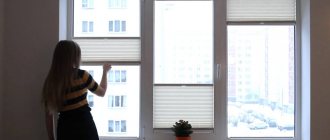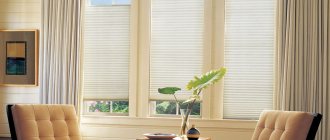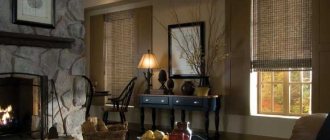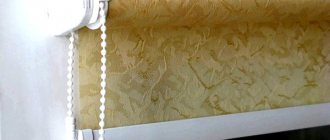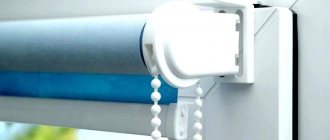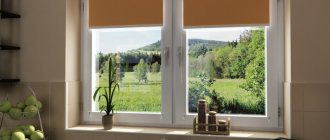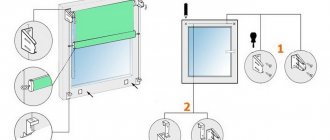Probably everyone can remember a boring school lesson in which we painted the margins of a notebook or crumpled a sheet of paper into an accordion, making a fan or a strange figure. This corrugated base is used to make pleated curtain designs. However, their main difference from a sheet of paper is their greater density, which prevents them from being damaged by the slightest impact. Today ReRooms will tell you about the main types and advantages of such curtains in the interior of an apartment or country house.
Photo: vorhang-koeppel.ch
Question #1: What kind of window do you have?
1. Conventional tilt-and-turn or sliding balcony design
(with an inclination angle of 0-15 degrees from vertical)
For you – a wide variety of tension, free-hanging pleated, “Day-Night” models. You can choose curtains with one or two movable curtain rods that fix the curtain at any window level. To prevent the curtain from sagging when the sash is tilted, install a window sill bracket or a lower fixed cornice.
Control type: cord, chain, plastic handle on a movable cornice, spring, electric drive.
Installation:
- In the opening, if its depth is at least 25 mm. Ceiling, window sill bracket is used
- On the opening using wall fasteners
- On the glass inside the bead (if its depth is not less than 15-25 mm)
- On the frame with and without drilling
- On a glazing bead (if its surface is flat, 1 cm wide).
- If you have a standard fixed window, it is recommended to install the curtain on the frame.
2. Inclined with a slope of up to 60 degrees from the vertical
For such windows, you should choose light filters with additional reinforced tension cords, which secure the curtains on the sides and prevent them from sagging. These are tension models, as well as “Day-Night” systems with fixation of the cornice at the top and bottom.
Control type: plastic or metal handle. If the curtain width is more than 80 cm, another handle is installed on the curtain rod.
Installation: All types of installation are suitable.
3. Ceiling window with a slope of 45-90 degrees, domed roof, winter garden
Your choice is special ceiling models with tension cords, reinforced with steel cable to prevent sagging of the fabric. The curtains are fixed to a fixed cornice at the top and bottom.
Control type: manual, motorized, using a cord. When manually controlled, the movable curtain rod is equipped with a plastic or metal handle, which can be supplemented with a special extension. This is an additional option for windows located at high heights. It is recommended to install a magnetic window sill bracket on the same windows. This option securely fixes the upper and lower curtain rods in the desired position and makes the process of controlling the handle more convenient.
Installation: on the ceiling or on the frame.
4. Window of complex shape
For non-standard vertical and ceiling windows, tension and free-hanging pleated windows of non-standard shape are chosen. Triangle, trapezoid, semicircle, any irregular shapes - nothing is impossible for making custom-made pleated curtains. Just provide the specialist with a window drawing or pattern.
Control type: handle, cord, chain, electric drive (for ceiling windows).
Installation: all types of installation, except for mounting on PVC brackets.
5. Panoramic window
The MAXI system has been developed for you with a fabric fold width of 32 mm and a cornice width of 48 mm.
Control type: motorized, cord, handle.
For tall windows, it is also recommended to choose the “cord with loops” option. A cord is installed on the reverse side of the fabric, which maintains an even distribution of folds over the entire height of the product. Without this option, the folds on a long fabric will be different in width due to its sagging.
Installation: on the ceiling, wall, frame.
6. Narrow or small window
Choose pleated fabric with a fold width of only 15 mm.
Control type: cord, chain, handle.
Installation: they are attached to the sashes or as close to the glass as possible, without drilling (on tape) or by drilling onto a bead.
7. “Non-working” window, interior opening, niche
Sometimes you need to cover a window that is not in use with a curtain (for example, in the bathroom of a country house, in the hallway), or decorate the opening or work surface with a decorative screen. For such cases, choose fixed forms of pleated curtains. This is a straightened canvas without control of rectangular, semicircular, triangular, or any other complex shape. Semicircular screens along the upper edge are fixed with eyelets and special hooks.
Their advantages
Like all roll-up pleated curtains, they have a number of advantages.
- They take up little space and free up the window sill as a work area.
- Pleated curtains are suitable for windows of non-standard shape: triangular, arched, attic windows.
- Easy to care for.
- Variety of fastening types and colors.
- Availability of models that do not allow excess noise and light to pass through.
- Universal to use and suitable for any room.
Light tulle will complement the laconic look of pleated curtains
Question #2: Why do you need pleated curtains?
The choice of filter fabric depends on the answer to this question: its type, density, transparency, texture.
In addition, depending on the functionality of the curtains, models with one or two curtain rods are selected, as well as the type of curtain opening (top to bottom, bottom to top). Why do you need pleated curtains?
The window is on the ground floor and you need to block the view from the street
The best option is a model with two movable cornices or pleated curtains with the door opening from the bottom up. They cover the lower part of the light opening, maintaining privacy. At the same time, the top of the window remains open to allow light into the room.
The window is located on the sunny side and you need to escape from the scorching sun
The solution to this situation is to install pleated fabric with blackout fabric. A special reflective layer is applied to the material. It does not allow the sun's rays to pass through and prevents the air in the room from overheating. Blackout is ideal for a bedroom or children's room. Such curtains will ensure a restful sleep, hiding the illuminated street outside the window.
You need to decorate the window, but at the same time not lack natural light
If you need to decorate a window in the attic or veranda, pleated fabric made of transparent fabric is a suitable option: it lets in up to 65% of daylight, gently dispersing it. This is a burnout fabric, as well as 100% polyester with a fine textured structure and imitation of natural materials (cotton, linen). For residential premises, you can choose pleated fabric screen: from inside the room, the feeling of space outside the window is preserved, but from the outside the curtains hide the view from prying eyes.
Need light filters for an office or other public institution
Optimal solutions for the office:
- blackout – for presentations at any time of the day;
- screen – to create soft lighting and protection from direct sunlight;
- curtains with impregnation, which protects against dust and dirt settling on the fabric.
For saunas and swimming pools, special models with a fabric suitable for wet rooms are chosen.
It is necessary to design a window in a room with increased fire safety requirements
In children's institutions and public places with large crowds of people, it is recommended to use pleated curtains made of Trevira fabric. It contains special non-flammable fiber. For your own safety, you can hang such curtains at home. The structure of the fabric is varied: these are plain fabrics, with glitter, and prints.
The room has panoramic glazing. It is necessary to protect the room from overheating in the summer, and to keep warm air inside in the winter
Pleated curtains made of corrugated fabric will come to the rescue. Its structure resembles a honeycomb: two sheets are connected to each other so that an air cell is formed between them. It retains air inside, protecting rooms from hypothermia in winter, and from overheating in summer. This is the optimal solution for both home and office. Even transparent corrugated fabrics hide the view from the street well thanks to their multi-layered texture.
Decorate a window in the kitchen
Teflon impregnation prevents dust, odor and small particles of fat from being absorbed into the fibers, maintaining the pleated appearance. Such models are well suited for the kitchen.
Decorate a window in a living room
There are plenty of options for decorating windows in living rooms. Blackout curtains are suitable for the bedroom, translucent models and the “Day-Night” system, plain or with a jacquard pattern, are suitable for the living room. For the nursery and kitchen, you can choose pleated fabrics with a print. It is worth considering that a large print does not always look good on pleated folds. Therefore, you should give preference to small patterns: herringbone, stripes, geometry and abstraction. The color of the product cords is chosen to match the color of the fabric.
The color of the cornice is to match the walls or windows.
General comparative characteristics
The advantages of all types of blinds include closing the window without taking up additional space, as is the case with curtains. And also the ability to adjust the darkening of the room: ordinary slats can be adjusted by location, pleated ones - by the height of the window closure.
All types of curtains are durable, but if one lamella fails, all the blinds have to be replaced, which does not happen with pleated curtains or roller models.
Pleated curtains take up the least space from the cornice. Therefore, they are often installed on balcony windows. They are also more durable and resistant to fading under the influence of sunlight.
In comparison with all types of blinds, only pleated curtains can be installed on a window of any geometry, which is important for private homes and luxury hotels.
You can choose any option for curtains, roller blinds, blinds and pleated blinds via the Internet. To choose a suitable style, you should contact a designer. You can order any design of pleated blinds in our online store.
How to install pleated?
There are several ways to install curtains:
Inside the opening
For installation, ceiling or window sill brackets are used - this depends on the pleated model. At the top of the opening, markings are made for installing brackets, and they are screwed into place. Insert the cornice into them until it clicks.
If window sill fasteners are used, mark the width of the product at the installation points. The support along with the washer is inserted into the installation stops, the place for drilling is marked, then screwed onto the screw. Window sill brackets are placed on these supports.
On the glazing bead
Ceiling and glazing bead brackets are used. First, their installation locations are marked, and the distance to the glass should not be more than 3 mm for curtains made of regular fabric and more than 5 mm for blackout fabric. To measure the required distance, use a setting stop. If the glazing bead is oblique, use a 15-degree wedge to level the cornice. Next, you need to screw the brackets to the glazing bead with two screws, and attach the ceiling ones to them. The bracket must be closed with a lid. All that remains is to insert the cornices.
On the opening (on the wall or ceiling)
Use wall or ceiling brackets. Similar to the two previous methods, markings are made for their installation on the wall or ceiling. The fasteners are screwed to the wall with two screws, then the cornices are inserted into them.
PVC window sash
Use cap or window sill brackets (if available). They are screwed onto the left and right sides of the flap, and if there are window sill fasteners, the supports are screwed onto the right and left brackets.
No drilling
For PVC flaps, you can use drop-in brackets without drilling. Pleated frames can be installed on a blank frame or glass using adhesive tape. The process is very simple: degrease the installation site, apply double-sided tape, then apply the profile level. The surface temperature of the frame or glass should be close to the temperature of the adhesive tape. If necessary, you need to warm it up a little with a hairdryer.
Photo gallery
Accordion pleated
Black pleated in gsstinoy
A riot of colors
The sea is agitated once...
Cocoa
In bathroom
Sea wave
Fuchsia
For windows of any size
Measurement according to the rules
In order for the curtain to “stand up” correctly, it must be measured correctly. Calculation of measurements depends on the method of installation of the pleated:
- When installing in an opening, measurements are taken at three different points in height and width, then the smallest value is selected. The height and width of the future product should be equal to the same parameters of the opening. When calculating, make sure that the height of the folded curtain will not prevent the sash from opening.
- When installed on an opening, the width and height of the future product are calculated as the width and height of the opening, increased by 10-15 cm.
- If you plan to install light filters inside the bead (on glass), you need to measure the height and width of the light opening along the glass, including the rubber seal. This installation method can be used if the bead depth is between 15 and 25 mm.
- When installing on the frame, take into account the dimensions of the bead: its width will correspond to the width of the curtain. To measure the height of the product, two values are taken into account: the height of the glazing bead and the brackets.
- The curtain can be installed on a glazing bead if it is flat (1 cm wide). In this case, the width of the pleat is equal to the width of the glazing bead, and the height is calculated depending on the curtain model. If the fastening is only at the top, subtract 1 cm from the height of the bead. If the fastenings are located at the top and bottom, then subtract 2 cm.
- When installed without drilling, the width of the product is equal to the width of the glazing bead, and the height is calculated according to the length of the sash.
If you have a window of complex shape, when measuring the dimensions of the curtains, you need to take into account the overlap. Usually it is at least 5 cm or equal to the height of the brackets. You can do it simpler: draw a life-size pattern of the future product. To do this, you need to trace the outline of a non-standard window on cardboard and cut it out, handing it over to specialists for making curtains. When ordering pleated pleats of complex shape, keep in mind that the width of the fabric must be equal to or greater than the length of the slope of the product - this should be looked at in the catalog.
Kinds
Varieties of pleated fabric can be classified according to different criteria. In terms of composition, it can be natural, artificial, or combined. Chiffon, velvet, silk, and polyester can be used in production. Leather is also used in production. Each type of material has its own characteristics.
- Polyester holds its shape well. It is resistant to fading and creasing. It has a matte surface and an opaque structure with a complex weave of threads.
- Knitwear can be cotton, viscose, wool, synthetic. The weave of the material is looped, it stretches perfectly in length and width. Pleated jersey pleats are thicker than others.
- Velvet is one of the densest materials that can be pleated. It has a short pile, which increases the thickness of the folds. Velvet pleated flatters the figure.
- Satin fabric has a twill weave and a characteristic lustrous sheen. It frays along the edges, is deformed diagonally, and is used for elegant clothing.
- Pleated mesh is used for the manufacture of specific clothing (tutu skirts, stage outfits). The material is artificial, transparent, resistant to stretching and deformation.
- Chiffon is one of the most capricious translucent fabrics. This is also reflected in the pleating. Chiffon pleating is thin, but wrinkles after washing. It has a matte texture and is vulnerable to snags.
- Crepe-satin pleated fabric may have lasses that are formed during the assembly of the folds. The material itself crumbles a lot, it has a matte surface and a complex weave of threads.
The most popular mixture options are made from:
- silk with the addition of viscose and acetate fibers;
- wool blend, cashmere and lycra;
- linen-elastane materials;
- combinations of cotton, viscose and polyester.
Based on color, fabrics are divided into 2 groups: plain and printed. Options of the first group have many shades, including neutral, pastel, bright, acidic, dark, muted colors. Colors depend on the density and purpose of the fabric.
Dress materials are decorated with floral, plant, and geometric prints. Popular designs are polka dots and checkered patterns. They are used when sewing business style clothes.
Proper care is the key to long service life
In order for light filters to serve for a long time, they must be installed only in enclosed spaces with air temperatures from 0 to +40C and a humidity level not exceeding 70%.
The operating rules are simple: do not allow mechanical damage, do not repair it yourself, do not suddenly lower or raise the curtain. There are two ways to care for pleated curtains: wipe with a damp sponge soaked in warm soapy water or wash by hand. This applies to transparent and translucent fabrics. Curtains made of opaque material have a reflective layer, so only dry cleaning is recommended for their care.
To wash the pleated fabric, it must be removed from the fastener and placed open in a warm solution with a neutral detergent (water temperature should not exceed 30 degrees). The curtain is soaked for 15-30 minutes, while it can be turned over by holding the profiles, but not twisted. Then the pleated is pulled out, also holding it by the upper profile, and washed open in the shower. To allow the water to drain, the pleated sheet needs to be folded and tilted slightly. Without waiting for the product to dry completely, you can install the fasteners in place.
The pleated takes about 12 hours to dry. The curtain must be folded during this process. Ironing the product is strictly prohibited.
Mounting and control methods
Pleated curtains are attached not only to modern plastic windows, but also to wooden, panoramic and attic ones. Adjustment of the light flux is carried out in several ways.
Electrically driven systems exist. You can also raise and lower the canvas by a rope, chain or leash manually.
